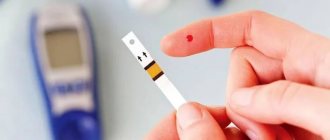Glucose plays a very important role in the human body, because it provides it with energy. However, this component must be kept normal, otherwise health problems will arise.
Every woman during pregnancy tries to be more attentive to her health. Often, a pregnant woman's blood sugar increases without any reason. This is explained by the fact that hormonal changes occur in a woman’s body, because now it works for two. However, if there is a reason, it must be identified as soon as possible. Therefore, expectant mothers are prescribed many tests, and donating blood for sugar is no exception. The results of blood tests can explain a lot, and if the results deviate from the norm, this can harm both the woman and her unborn child.
Blood sugar levels in pregnant women according to new standards
If a woman has had perfect blood tests all her life, this may change during pregnancy. The normal level of sugar in pregnant women is considered to be from 3.3 to 5.5 mmol/l on an empty stomach, and 2 hours after a meal 6.6 mmol/l. When the level of glucose in capillary blood is above 5.2 mmol/l, a diagnosis of diabetes mellitus is made. In this case, a stress test is prescribed to measure the response of glucose to carbohydrates. The diagnosis will be confirmed if after an hour the level is 10 mmol/L or higher.
An analysis of blood glucose levels is required throughout pregnancy. Neglecting this procedure can lead to dire consequences. If you are overweight or have poor heredity, the analysis should be carried out every month for preventive purposes. Blood glucose levels can vary due to late-night snacking, medications, and emotional distress.
Table of blood sugar norms during pregnancy
Diet for diabetes in pregnant women
Easily digestible carbohydrates are completely excluded from the diet (they are quickly absorbed from the intestines and increase blood glucose levels within 10-30 minutes after consumption):
- Sugar, fructose, jam, honey, caramel, candies, chocolate;
- Fruit juices (including juices provided in the antenatal clinic);
- Lemonades;
- Ice cream, pastries, cakes, condensed milk;
- Bakery products made from high-grade flour;
- Butter pastries (buns, buns, pies).
Foods with a high glycemic index are completely excluded from the diet .
The glycemic index (GI) is a measure of the effect of food on blood sugar levels. Each food is given a score from 0 to 100 depending on how quickly it raises your blood glucose levels. Glucose has a GI of 100, meaning it enters the bloodstream immediately, which is the benchmark against which other foods are compared.
Another indicator that helps predict how high your blood sugar level will rise after a meal and how long it will stay at this level is the glycemic load (GL) . Calculated using the formula:
GL = [GI (%) x amount of carbohydrates per serving (g)] / 100
Glycemic load shows that eating foods with a low glycemic index but high amounts of carbohydrates will not be effective in maintaining normal post-meal blood sugar.
For example, let’s compare the glycemic load of different foods:
Watermelon:
GI – 75, carbohydrates – 6.8 g per 100 g of product, GL = (75x6.8) / 100 = 6.6 g.
Donuts:
GI – 76, carbohydrates – 38.8 g per 100 g of product, GL = (76x38.8) / 100 = 29.5 g
Crumbled buckwheat:
GI – 50, carbohydrates – 30.6 g per 100 g of product, GL = (50x30.6) / 100 = 15.3 g.
Pearl barley:
GI – 22, carbohydrates – 23 g per 100 product, GL = (22X23) / 100 = 5.1 g.
Obviously, the glycemic load of foods increases as the amount of carbohydrates consumed and the glycemic index increase. Accordingly, it is possible to control the glycemic load by consuming low-GI foods in small portions several times a day.
Glycemic load scale:
During one meal
- Low up to 10 g;
- Average from 11 to 19 g;
- High – more than 20.
During the day
- Low up to 80 g;
- Average from 100 to 120 g;
- High – more than 120.
It is necessary to give preference to foods with a medium and low glycemic load, consuming food in small portions, several times a day, excluding the intake of easily digestible carbohydrates.
It is necessary to exclude foods that have a high GI:
- Sweet fruits and berries: grapes, bananas, persimmons, figs, cherries, melon, dates;
- Vegetables: Potatoes, parsnips, pumpkin, boiled beets, boiled carrots, canned sweet corn and peas;
- Porridges – millet, wheat grits, semolina, millet, polished varieties of rice, as well as all instant porridges;
- Homemade noodles, rice noodles;
- Milk;
- Varieties of white or black bread made from premium quality flour.
Also, you should not eat foods containing large amounts of hidden fat, so as not to gain unnecessary weight:
- Meat delicacies;
- Sausages;
- Sausages;
- Sausages;
- Carbonates;
- Ham;
- Salo;
- Buzhenina;
- Offal.
Preference is given to products with medium and low GI:
- Vegetables: Any cabbage (cabbage, broccoli, cauliflower, Brussels sprouts, collards, kohlrabi), salads, greens (onion, dill, parsley, cilantro, sorrel, mint, basil, asparagus, spinach, wild garlic, tarragon), eggplant, zucchini, pepper , radish, radishes, cucumbers, tomatoes, asparagus, onions, garlic, squash, turnips, paprika, capsicums, raw carrots;
- Legumes: peas, beans, lentils, beans;
- Mushrooms;
- Fruits: Grapefruit, lemon, lime, kiwi, orange, apples, pears, tangerine;
- Berries: chokeberry, lingonberry, blueberry, blueberry, blackberry, feijoa, currant, wild strawberry, strawberry, raspberry, gooseberry, cranberry, cherry;
- Fermented milk products - kefir, fermented baked milk, yogurt, ayran, tan (no more than 1 glass at a time), yogurt, cottage cheese, cheese;
- Meat, chicken, fish. When cooking, remove visible fat and render as much of it as possible. The best culinary processing of foods is boiling, steaming, baking, open fire.
How to reduce the glycemic index and glycemic load:
- Combine starchy foods with a medium GI with vegetables that have a low GI;
- Pasta made from durum wheat flour without vegetables is worse than the same pasta with vegetables;
- Do not cook durum wheat pasta until it becomes sticky;
- Eat whole grain porridge (preference is given to: pearl barley, buckwheat, oatmeal, wheat, spelt, bulgur) and wholemeal bread with bran;
- It is better to simply brew porridge (buckwheat, rolled oats) with boiling water and keep it warm for several hours. Then starch under the influence of water and high temperature will not transform into a state that is easily and quickly absorbed by the body;
- The more a product is crushed, the higher its glycemic index. There is nothing not to puree;
- Eat whole fruits (unlike juices, they contain fiber, which reduces GI);
- Give preference to raw vegetables. Vegetables that are subject to heat treatment should not be boiled. Fiber is not destroyed during this treatment;
- Try, whenever possible, to consume vegetables and fruits with the skin, which consists of whole fiber;
- Combine protein foods with vegetables, eat starches at the same time as proteins;
- Dress salads with a small amount of olive oil (1 tablespoon) with lemon juice;
- Fat also lowers the glycemic index;
- If you really want something sweet, eat it along with proteins and foods rich in fiber and fat;
- Products containing carbohydrates with a high amount of dietary fiber should make up no more than 45% of the daily calorie intake, they should be evenly distributed throughout the day (3 main meals and 2-3 snacks) with a minimum carbohydrate content for breakfast, because. the counter-insular effect of increased levels of maternal hormones and the feto-placental complex in the morning increases tissue insulin resistance;
- Breakfast should be “protein” (cottage cheese, egg, meat, fish, chicken with vegetables). This allows you to improve blood sugar levels in the first half of the day after breakfast, before and after lunch.
Food and lowering sugar during pregnancy
| Food | Low GI (slowly digested carbohydrates, slowly raise blood sugar) | Medium GI ( slowly digested carbohydrates, do not quickly raise blood sugar) | High GI ( quickly digestible carbohydrates, quickly increase blood sugar) |
| Fruits and berries | Grapefruit, lemon, lime, kiwi, orange, chokeberry, lingonberry, blueberry, blueberry, currant, strawberry, strawberry, raspberry, gooseberry, cranberry, cherry | Apricot, peach, plum, tangerine, pear, pomegranate, mango, papaya, apple | Grapes, banana, persimmon, figs, cherries, watermelon. Melon. All juices and freshly squeezed juices |
| Vegetables and legumes | Any cabbage (white cabbage, broccoli, cauliflower, Brussels sprouts, collards, kohlrabi), salads, greens (onions, dill, parsley, cilantro, tarragon, sorrel, mint), eggplant, zucchini, peppers, radishes, radishes, cucumbers, tomatoes, artichoke , asparagus, leeks, garlic, onions, green beans, spinach, soy | Corn on the cob, raw beets and carrots, sweet corn sprouts, beans, peas, chickpeas, mung beans | Potatoes, pumpkin, boiled beets and carrots, canned corn and peas |
| Cereals | Buckwheat, barley, pearl barley, wheat | Red rice, wild rice, white brown rice, pearl barley, oatmeal, quinoa, bulgur | Millet\millet, wheat grits, semolina, couscous, white polished rice, sushi rice, cereal, muesli. Instant porridge |
| Flour and pasta products | Sprout bread without flour | Pasta made from durum wheat, whole grain bread or crispbread made from whole grain flour | All products made from premium wheat and rye flour, rice flour, rice and buckwheat noodles, cakes, pastries, cookies, waffles, chips |
| Dairy | Sour cream, cottage cheese, unsweetened yogurt (no additives) | Kefir, fermented baked milk, yogurt, acidophilus, whole fat milk | milk, sweet fermented milk products, sweet yoghurts and curds, glazed curds |
| Nuts/seeds | All nuts and seeds | ||
| Sweets | Dark chocolate ≥ 75% cocoa, carob, urbech without sugar | Milk chocolate, halva, ice cream, cookies made with amaranth, flax or buckwheat flour without sugar | Sugar (any), honey, preserves, jams, marshmallows, marshmallows, confectionery and baked goods |
Regular physical activity is important in the treatment of gestational diabetes:
Physical activity lowers blood sugar levels and helps you avoid gaining excess weight.
Recommended physical activity: brisk walking or Nordic walking 10-15 minutes after main meals to improve blood sugar control after meals, and 30 minutes before bed, which will help normalize fasting blood glucose levels.
Pregnant women with gestational diabetes mellitus should conduct regular self-monitoring - measuring glycemia using self-monitoring devices (glucometer) - on an empty stomach and 1 hour after each main meal, sometimes before meals and 2 hours after meals.
Self-control targets:
- Fasting <5.1 mmol/l;
- 1 hour after eating <7.0 mmol/l;
- Before meals <5.8 mmol/l;
- 2 hours after eating <6.7 mmol/l.
Pregnant women regularly need to monitor ketone bodies in the urine to identify insufficient carbohydrate intake from food, since the “rapid fasting” mechanism with a predominance of fat breakdown can immediately start. Measurements are taken in the morning urine sample. If ketone bodies appear in the urine (the test strip has changed color), then you need to additionally eat 12-15 g of carbohydrates (a glass of kefir, an unsweetened cracker, an apple) before going to bed to shorten the long period of fasting at night.
Keeping a personal self-control diary, where you must enter:
- glycemic measurement indicators;
- dietary habits (number of foods eaten) at each meal;
- physical activity;
- the level of ketones (acetone) in the morning urine (using urine test strips for ketones);
- weight (weekly);
- blood pressure values;
- fetal movements.
If, against the background of diet therapy and regular physical activity, it is not possible to achieve target blood glucose values within 1-2 weeks, then the pregnant woman is prescribed insulin therapy (tablet glucose-lowering drugs are contraindicated during pregnancy!).
Prescribing insulin for gestational diabetes mellitus is possible even against the background of normal indicators of self-control of glycemia, but according to ultrasound of the fetus, signs of diabetic fetopathy are revealed (the size of the fetus is ahead of the gestational age, the abdominal circumference exceeds the head circumference, there is swelling of the soft tissues of the fetus, polyhydramnios, changes in the placenta) .
For therapy, insulin preparations that have passed all stages of clinical trials and are approved for use during pregnancy are used. Insulin does not penetrate the placenta and has no effect on the fetus, but excess glucose in the mother’s blood immediately goes to the fetus and contributes to the development of those pathological conditions mentioned above.
Accustomment to insulin does not develop; insulin is discontinued after childbirth.
How does the analysis take place?
Blood for analysis is taken from a vein (venous blood) and from a finger (capillary blood). The normal level of venous blood should vary from 4 to 6.3 mmol/l, and capillary blood from 3.3 to 5.5 mmol/l. The test results are influenced by the woman’s condition, so it is worth preparing for the procedure. For the most accurate results, it is recommended not to eat food in the evening, and also avoid sugary drinks or juices. Before taking the test, you should protect yourself from stressful situations and have healthy sleep. If you feel unwell, tell your doctor, because... this may affect the test results.
The importance of the analysis also lies in the fact that it allows for the timely diagnosis of gestational diabetes. Sometimes the level of glucose in the blood indicates the manifestation of diseases that were previously dormant.
If the results are abnormal, there is no need to worry or panic. Tests will be ordered again, because a change may occur due to environmental influences or non-compliance with blood sampling rules.
False results
There are cases of false positive results when a woman is not sick, but for some reason her glycemic levels are outside the acceptable range, as indicated in the test results. This may be due to the following conditions:
- stressful situations - women during pregnancy are the most emotional and susceptible to such influence;
- recent infectious diseases;
- violation of the rules for taking tests - a pregnant woman may eat something or drink tea before taking the material, thinking that “it won’t do any harm.”
There is no need to panic in advance. The tests can be retaken; in addition, a glucose tolerance test will confirm or refute the pathological condition. You can also consult an endocrinologist.
Elevated blood sugar
Elevated blood glucose levels indicate hyperglycemia. Doctors associate this phenomenon with diabetes before a woman’s pregnancy, or with the development of gestational diabetes during pregnancy. Excessive amounts of glucose contribute to metabolic disorders, and this affects the health of the woman, and, accordingly, the health of the child. Glucose leaks through the placenta into the baby's bloodstream, and increases the load on the pancreas, which in turn has not formed and cannot cope with it. The pancreas begins to work at an increased rhythm and secretes double the amount of insulin. Insulin speeds up the absorption of glucose, converting it into fat - this leads to excess weight in the baby. This process can cause diabetes in the baby while still in the womb.
With the test strip you can measure the concentration of glucose in your blood yourself
Reasons for violations
It should be noted that an increase in sugar associated with bearing a child is a fairly common phenomenon, caused by the activation of pathological processes that were previously present in the body, but do not make themselves felt.
- Normal blood sugar (glucose level): table by age
Gestational diabetes, observed only in pregnant women, usually goes away without a trace after childbirth. But even this type of pathology poses a threat to the mother and child, so it is unacceptable to ignore it.
Among the main reasons for increased sugar during pregnancy are:
- A significant increase in the load on the pancreas and a decrease in the effectiveness of natural insulin.
- Increased glucose levels due to hormonal changes.
- Gestational diabetes in previous pregnancies.
- Age over 30 years.
- Excessive fullness.
- Polycystic ovary syndrome.
- Glucose in urine.
- Large fruit size.
- Hereditary predisposition to diabetes.
Young women are less likely to develop diabetes during pregnancy.
Additional circumstances
In addition to the described factors that can lead to deviations from the norm, other reasons should be noted.
This:
- excessive emotionality, stress typical for pregnant women;
- presence of infection in the body;
- violation of the rules for preparing for analysis.
Detection of deviations up/down is an indication for re-testing.
Prerequisites for increased glucose
Symptoms of high blood sugar in women
The doctor caring for the pregnancy may notice some signs that indicate elevated blood sugar levels. These symptoms include:
- increased feeling of hunger;
- frequent urination;
- constant feeling of thirst;
- daily weakness, fatigue;
- high blood pressure.
With such symptoms, the doctor prescribes a blood and urine test to make a correct diagnosis and rule out a condition called “latent diabetes.” If the indicators are slightly elevated, this can be considered normal, because During pregnancy, the pancreas in women is not able to function normally, which is why the level of glucose in the blood increases. To be on the safe side, the doctor may prescribe strict adherence to a diet, or minor restrictions on the consumption of certain foods.
A blood test is one of the most important tests during pregnancy.
Low blood sugar
Low sugar levels are much less common than high sugar levels. A decrease in blood glucose levels in pregnant women is even more dangerous than an increase. Glucose supplies the body of a pregnant woman and her fetus with energy, and if its amount is below normal, it will adversely affect the health of both. Hypoglycemia is more noticeable when test results are less than 3.4 mmol/l, while the sugar level during pregnancy should not be lower than 4 mmol/l.
The causes of this complication:
- early toxicosis (severe course);
- unbalanced diet;
- long gaps between meals.
If a pregnant woman eats rarely and in small portions, then the energy obtained from food is consumed in a couple of hours. The body of the mother and her fetus experiences a lack of energy (glucose deficiency).
Frequent consumption of sweets and foods with a high glycemic index provokes sharp surges in glucose in the body, and the pancreas begins to produce more insulin for absorption. As a result, the blood sugar level drops, the woman begins to feel tired and drowsy, and the desire to eat something sweet appears. Therefore, it is very important to have a standardized diet that contains useful substances and microelements.
If you have gestational diabetes, purchase a glucometer to monitor your sugar levels
Risk groups for diabetes mellitus during pregnancy
- first pregnancy in women over 35 years of age;
- bad heredity;
- second pregnancy when the weight of the firstborn is above normal;
- women who had miscarriages or gave birth to stillbirths;
- overweight mom;
- high water
Reasons for the decrease in indicators
Low sugar is quite rare.
A prerequisite for this may be severe early toxicosis, an unbalanced or unhealthy diet, low weight, or excessive thinness. Sugar levels drop when the glandular tissues of the pancreas begin to produce more insulin than required. As a result, hypoglycemia develops. An attack can be triggered by too long a period of time between meals or by eating small portions. As a result, blood sugar from 5.2 mmol/l can very quickly drop to three or less mmol/l.
Another provocateur for reducing sugar levels may be eating low-calorie foods. In this case, the woman does not receive enough energy due to insufficient nutrition.
A slight decrease in glucose is indicated by headaches, nervousness, trembling throughout the body, and constant sweating. The average severity of the syndrome is manifested by irritability, slow speech, inability to navigate, and muscle cramps. If sugar drops to 1.1 mmol/l, then it may be:
- loss of consciousness;
- seizure attack;
- stroke;
- death.
Nocturnal episodes of hypoglycemia are more difficult to identify. Their symptoms include unusual breathing noises, restlessness, nightmares, and excessive sweating.
Gestational diabetes
Gestational diabetes mellitus (GDM) manifests itself in mild symptoms, making it quite difficult to detect in a timely manner. According to statistics, at least 10% of pregnant women experience it. Usually it makes itself felt by the end of the second or beginning of the third trimester. In 90% of cases, this disease goes away on its own after childbirth, even if no treatment was prescribed. Women whose gestational diabetes resolves after childbirth are at risk of developing type 2 diabetes later. A blood sugar test is the best way to detect this disease. This test can be carried out either in a special laboratory or at home, the main thing is to know your blood sugar levels.
Gestational diabetes is dangerous because it harms the health of the woman and the unborn child.
A number of consequences that gestational diabetes leads to:
- fetal loss;
- overweight in a pregnant woman;
- problems with the cardiovascular system;
- hypoxia and asphyxia during childbirth;
- hyperbilirubinemia;
- diabetic fetopathy in an infant;
- disorders in the child’s bone tissue;
- disorders in the central nervous system of the fetus.
Insulin preparations approved for use during pregnancy
Rules for storing insulin and administering injections
- Sealed vials and cartridges with insulin should be stored in the refrigerator at a temperature of +4–8°C; opened ones can be kept at room temperature no higher than +25°C for one month;
- Before using a new bottle, you must check the expiration date information;
- You cannot use an insulin syringe pen if its body has cracks, the cartridge is not tightly screwed to the piston, or the pen body is wet from leaking insulin;
- The needle should be changed after each injection, as crystallization of insulin and “clogging” of the needle may occur, which will lead to inaccurate administration of the drug dose;
- Before the injection, it is necessary to “reset” 1 unit of insulin;
- If the insulin does not "reset", it may be low or the plunger is not touching the rubber cap inside the cartridge;
- Optimal absorption of insulin is ensured when it is administered into the subcutaneous fatty tissue. To do this, use two fingers – the thumb and index – to form a skin fold;
- For best absorption of the drug, it is recommended to hold the fold;
- Continue to press the plunger of the syringe pen for 10–15 seconds after the end of the injection so that all the required amount of insulin has time to flow out of the needle;
- If you practice good personal hygiene and use disposable needles for hypodermic insulin injections, there is no need to wipe your skin with alcohol before injection. Alcohol causes the destruction of insulin and has a tanning or irritating effect on the skin.
Hypoglycemia is a condition characterized by low blood sugar levels. Hypoglycemia is considered to be blood sugar below 3.9 mmol/l during pregnancy only during insulin therapy. It is very rare in gestational diabetes mellitus.
Causes of hypoglycemia in gestational diabetes mellitus:
- Too much insulin was administered;
- Lack of carbohydrates in the diet;
- Skipping meals;
- Too intense physical activity.
Signs of hypoglycemia:
- Headache, dizziness;
- Hunger;
- Visual impairment;
- Restlessness, feeling of anxiety;
- Frequent heartbeat;
- Sweating;
- Shiver;
- Deterioration of mood;
- Poor sleep;
- Confusion.
What others might notice if you experience hypoglycemia:
- Pallor;
- Drowsiness;
- Speech disorders;
- Anxiety, aggressiveness, inappropriate behavior;
- Impaired concentration.
Algorithm of action for signs of hypoglycemia
- Stop any physical activity;
- Determine your sugar level - is it really low?
- Immediately eat or drink something containing quickly digestible carbohydrates: 100 ml of juice, or 4 pieces of sugar (can be dissolved in water;
- After this, you need to eat or drink something containing slowly digestible carbohydrates in quantity (a glass of kefir,
- piece of bread, apple).
The most reliable method of preventing hypoglycemia is regular self-monitoring of glycemia.
Let's sum it up
Don't neglect getting your blood sugar tested. A lot depends on your glucose level. If the level is elevated, the likelihood of developing obesity in the fetus increases. If the level is low, then the baby in the womb experiences a lack of nutritional energy, for this reason it is difficult for him to develop, which can lead to death. If your blood sugar deviates from the norm, do not panic prematurely; a repeat test will be ordered to clarify the result. It is necessary to inform the doctor leading the pregnancy about any symptoms that appear, this can prevent the development of any disease. Eat healthy and varied, and what foods will be good for you - check with your doctor.










